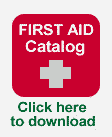 |
Toll Free 1 (800) 480-1277 |
Loading
|
|

![]()
First Aid Kits:
We have a selection of many different first
aid kits for schools, Industrial
settings, Businesses, Emergencies, CPR, etc...

|
Adult CPR Establish
Unresponsiveness
Infant CPR Establish
Unresponsiveness
Choking Ask: Are
you choking? If patient can talk or has poor air exchange
Bleeding Control ·
Direct pressure over the wound using the hand or a pressure dressing
Inadequate blood flow to the tissues and organs of the body. It is brought on whenever there is severe injury to the body or a shock to the nervous system. All bodily processes are affected. Vital functions slow down. In the early stages the body compensates for a decreased blood flow to the tissues by constricting blood vessels in the skin, soft tissues, and muscles. This causes the patient to have: Cold, clammy,
pale skin As shock progresses, the patient will become apathetic and relatively unresponsive, and pupils will dilate, finally becoming unconscious. TREATMENT for shock is as follows: ·
Check ABC's (Airway, Breathing, Circulation)
Generally, heart attacks occur in 2 forms, angina pectoris and myocardial infarction (MI). The symptoms of both are the same: pain in the chest region radiating to the jaw and arms; pale, sweating skin; weak pulse; shortness of breath; nausea. The differences are: Angina occurs when oxygen demand exceeds supply during physical or emotional stress. Pain subsides with rest, oxygen and nitroglycerine, and lasts only 3 to 8 minutes. MI (Myocardial Infarction) pain is not related to stress and is not relieved by rest or nitroglycerine. This pain lasts more than 10 minutes. Treatment in both cases consists of: ·
Check ABC's (airway, breathing, circulation)
Seizures Protect the patient from injury during seizure. Then maintain Airway, Breathing, and Circulation. If the patient regains consciousness, reassure and calm him/her.
Diabetes Diabetes is a disease in which the body is unable to use sugar at a cellular level. Insulin is a drug used by diabetics to promote cellular use of sugar. When a diabetic uses his insulin but does not eat, Insulin Shock may occur. By not eating, this person has failed to replenish the sugar levels in his body, leaving the insulin nothing to work with. Since the brain needs a constant supply of sugar, shock and unconsciousness will occur if the sugar levels are not replenished. Symptoms: Pale, moist skin; dizziness, headache; full, rapid pulse; thirst; slurring speech, seizures; coma. Sometimes mistaken for alcohol intoxication. Treatment: Immediate improvement following oral administration of carbohydrates (sugar, candy, juice, soda pop). If a diabetic fails to take insulin, his/her body cannot use sugar for cellular energy, and other, more harmful sources of energy are used. The result is acid waste products in the blood and excessive fluid loss causing Diabetic Coma. Symptoms: Air hunger manifested by deep sighing respirations; dehydration manifested by dry, warm skin; a sweet or fruity breath odor; a rapid weak pulse; unresponsiveness Treatment: Prompt transport to hospital for insulin When in doubt, give sugar! It will not worsen a diabetic coma, but will help insulin shock.
Hypothermia Cause: Prolonged exposure to cold. Water conducts heat 250 times faster than air. Symptoms: Low body temperature; shivering; apathy and sleepiness; slow heart rate and respirations, unconsciousness. Treatment: ABC's; rewarming by drying the patient, wrapping in a blanket, and moving out of the wind. Hot fluids if tolerated. Use vehicle heater if conditions permit.
Heat Exhaustion Cause: Overexposure to heat Symptoms: Weakness; cool and clammy skin; excessive sweating; nausea Treatment:
Bring to cool, airy place; lay victim down, feet elevated; liquids unless
Heat Stroke Cause:
Failure of the sweating mechanism, allowing body temperature to rise to
Symptoms: Hot, dry, red skin; full rapid pulse; throbbing headache; unconsciousness Treatment: Immediate cooling by applying cold water and fanning; call an ambulance.
Burns are classified by degree. First Degree is a reddening of the skin such as a mild sunburn. Second Degree is when the skin blisters, as in a deep sunburn or direct contact with hot objects. Treatment for First and Second Degree burns is to immerse in cold water for 15 minutes then apply sterile dressing. Cold compresses reduce pain. A Third Degree burn is when the skin is charred. Treatment is to cover burn with a sterile dressing and treat for shock. ·Do
not apply ice
Do not examine eyes with dirty hands. Foreign particles should be rinsed out using eye wash or clean water. Use a Q-tip for stubborn particles. If something is stuck in the eye, cover both eyes and let a doctor remove it.
Impaled object Treatment: Do not remove
object
Fractures & Splinting A fracture is a break in the bone and is either closed or open. Closed fracture: The bone is broken but there is no connecting wound from the break in the bone through the skin. Open fracture: The bone is broken with connecting wound through the surface of the skin. The danger of infection exists. Symptoms include: swelling, pain, tenderness, deformity, protruding bone, grating sound. The treatment is to prevent further damage. Immobilize the fracture by applying gentle traction and splinting. These steps should also relieve pain. Splints should always be long enough to extend beyond the joint just above and below the fracture bone. Check the pulse and feeling around the fracture site.
|













